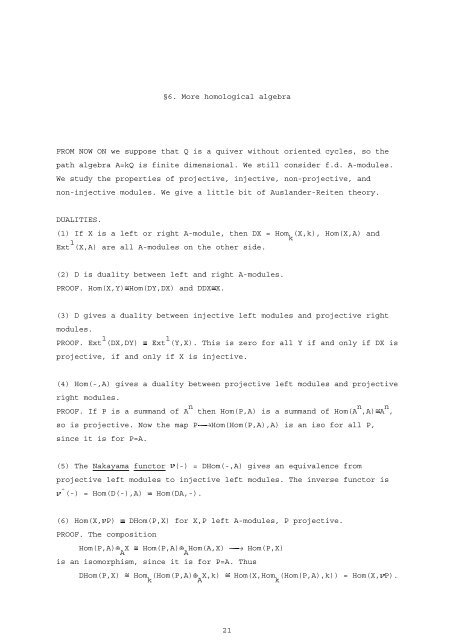Lectures on Representations of Quivers by William Crawley-Boevey ...
Lectures on Representations of Quivers by William Crawley-Boevey ...
Lectures on Representations of Quivers by William Crawley-Boevey ...
Create successful ePaper yourself
Turn your PDF publications into a flip-book with our unique Google optimized e-Paper software.
§6. More homological algebra<br />
FROM NOW ON we suppose that Q is a quiver without oriented cycles, so the<br />
path algebra A=kQ is finite dimensi<strong>on</strong>al. We still c<strong>on</strong>sider f.d. A-modules.<br />
We study the properties <strong>of</strong> projective, injective, n<strong>on</strong>-projective, and<br />
n<strong>on</strong>-injective modules. We give a little bit <strong>of</strong> Auslander-Reiten theory.<br />
DUALITIES.<br />
(1) If X is a left or right A-module, then DX = Hom (X,k), Hom(X,A) and<br />
k<br />
1<br />
Ext (X,A) are all A-modules <strong>on</strong> the other side.<br />
(2) D is duality between left and right A-modules.<br />
PROOF. Hom(X,Y) Hom(DY,DX) and DDX X.<br />
(3) D gives a duality between injective left modules and projective right<br />
modules.<br />
1 1<br />
PROOF. Ext (DX,DY) Ext (Y,X). This is zero for all Y if and <strong>on</strong>ly if DX is<br />
projective, if and <strong>on</strong>ly if X is injective.<br />
(4) Hom(-,A) gives a duality between projective left modules and projective<br />
right modules.<br />
n n n<br />
PROOF. If P is a summand <strong>of</strong> A then Hom(P,A) is a summand <strong>of</strong> Hom(A ,A) A ,<br />
so is projective. Now the map P ¡ Hom(Hom(P,A),A) is an iso for all P,<br />
since it is for P=A.<br />
(5) The Nakayama functor (-) = DHom(-,A) gives an equivalence from<br />
projective left modules to injective left modules. The inverse functor is<br />
-<br />
(-) = Hom(D(-),A) Hom(DA,-).<br />
(6) Hom(X, P) DHom(P,X) for X,P left A-modules, P projective.<br />
PROOF. The compositi<strong>on</strong><br />
Hom(P,A) X Hom(P,A) Hom(A,X) ¡ Hom(P,X)<br />
A A<br />
is an isomorphism, since it is for P=A. Thus<br />
DHom(P,X) Hom (Hom(P,A) X,k) Hom(X,Hom (Hom(P,A),k)) = Hom(X, P).<br />
k A k<br />
21

















